The Untold Story (Well, Until Today)
Before I begin today's column, you need to watch the video below. (You might have already seen it last Tuesday.)
Now that you've seen that, we can begin.
Welcome to Phyrexia Week, the companion theme week to Mirrodin Week from two weeks ago. This week we'll be exploring Phyrexia in all its facets. As "Action" has finally been revealed to be New Phyrexia, it's time for me to tell you the story of Scars of Mirrodin design because, as you'll see, I had to leave a few things out.
- Did I Forget To Mention...
I'll begin with a trivia question. Who was the first lead designer of New Phyrexia?
I assume many of you are guessing Ken Nagle, as he was the lead designer of the set codenamed "Action." The correct answer, though, is me. So, I used to be the lead designer of "Action?" No, Ken's always been the lead designer of "Action." I'll give you a second to fill in the blanks.

Yes, originally Scars of Mirrodin was supposed to be New Phyrexia. Say what? How exactly did that happen? It's an interesting story. I'm glad I have design column and a Phyrexia theme week to discuss it.
The beginning of this story goes back many years back to when I was in charge of the creative team. (Yes, once upon a time in addition to overseeing all of design I also had the entire creative team reporting to me.) At the same time I was putting together my original six-year plan (starting with Ravnica and going through Scars of Mirrodin) for Randy Buehler, who was the director of Magic Ramp;D, the position now filled by Aaron Forsythe.
I was looking for different things to base blocks around, and one idea I had was to go to the creative team with a question: "If we could visit any world, from a creative standpoint, what would be the coolest world to visit?" The answer I got was Phyrexia. As I explained two weeks ago, Brady Dommermuth (the guy now in charge of the creative team and the only person along with myself to be involved closely with both the Mirrodin and Scars of Mirrodin blocks) had planned when he designed the world of Mirrodin the elements that would ultimately turn it into New Phyrexia.

Quick aside for people who might not know the back story of Phyrexia. Note that this is the super-short, one-paragraph version. Phyrexia first showed up way back in Antiquities when they managed to influence Mishra in his war against his brother Urza. Phyrexia was run by a guy named Yawgmoth (he had quite a will, apparently). The Phyrexians kicked around Urza a number of times, so Urza decided he needed to get rid of them. His plan wove through the Weatherlight Saga and ended up with the destruction of the plane of Phyrexia. Everyone assumed the Phyrexians had been destroyed, but little did they know that Karn had been tainted many years earlier—and that infection led him to unintentionally taint the world of Mirrodin, which he, by the way, created. (For those of you that are fans of Karn: you might want to check out New Phyrexia. The set will finally reveal what has happened to him.)
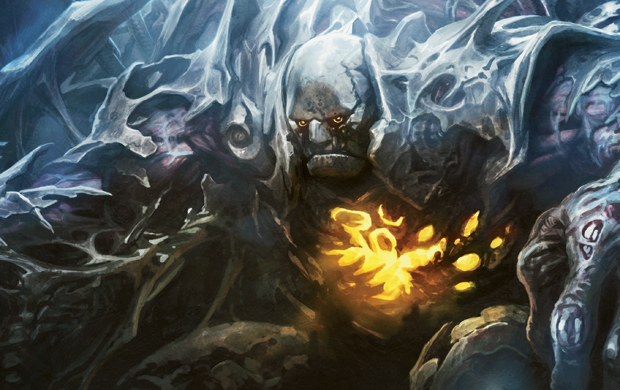
The point is that at the time of Mirrodin block, we had just watched the destruction of the Phyrexians a few years earlier, in Invasion block, and Brady was setting up for the return of Phyrexia. The idea was that when we returned to Mirrodin many years later it would now be New Phyrexia as the Phyrexian infection just hinted at in the original Mirrodin block would have had the time to do its thing.
When my team and I (myself, Mark Gottlieb, Alexis Janson, Erik Lauer, Matt Place, Mark Globus, and Nate Heiss) first sat down to design Scars of Mirrodin we were, in fact, designing New Phyrexia. The idea was that the Phyrexians had already overrun the world and turned it into New Phyrexia. One of the big questions for the block was what was it about. The creative team had an idea for five praetors, one of each color, that each had very different ideas of what New Phyrexia should be. (Be sure to check out New Phyrexia if this sounds cool.) Original Phyrexia was black in color. This time around we wanted to have the Phyrexians interact with all five colors of Magic.
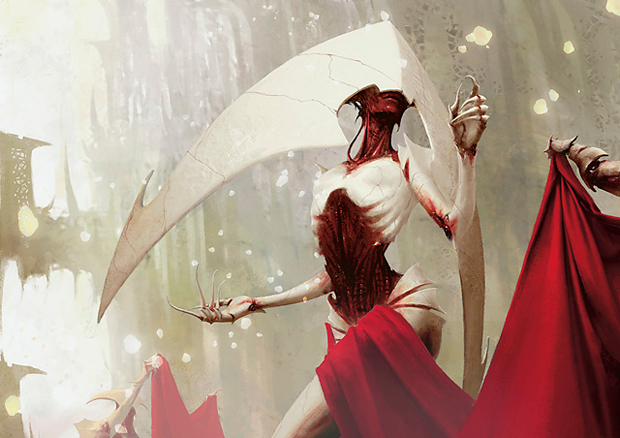
During this initial period we came up with the idea for living weapon as well as began to explore how poisonous should work. (My original articles on Scars of Mirrodin design, Something Wicked This Way Comes—Part 1, Part 2, and Part 3—explain how infect came about from poisonous.) During this entire time though there was a nagging issue that kept popping up in design meetings. It was cool that Phyrexia won, but how exactly did they do it? The Mirrans, we knew, were no slouches when it came to combat. How exactly did the Phyrexians beat them?
While all of this was going on, Bill Rose, the VP of Ramp;D, told me that he really liked how the Zendikar block was coming together and that he wanted to make sure we had a tight block plan for New Phyrexia. From time to time, he'd pull me into his office and ask me how the block plan was coming. I was struggling because I wasn't quite sure what story we were supposed to be telling. Meanwhile, I kept having team members coming to me wanting to see Phyrexia defeating Mirrodin. While I was trying hard to complete my assigned task, I agreed with them that we were missing out on what seemed like a cool story.
- Ch...Ch...Changes
Finally, came the day that Bill pulled me in his office and asked the same question he'd always asked me. What was the New Phyrexia block going to be about? I took a deep breath and said, "Bill, I think we're telling the wrong story."
I went on: "Mirrodin is the best selling set of all time. Obviously, there was something about it people liked. At the same time, we are trying to reintroduce the Phyrexians, which I believe are Magic's iconic villains. The reason I pitched the Phyrexian block in the first place was that I think a lot of players are going to be excited to see the Phyrexians back. I think, though, we've skipped over an awesome story. Fine, the Phyrexians are going to beat the Mirrans, but why don't we show that story? In fact, we could build the whole block around the conflict. We could get the players invested in who's going to win."
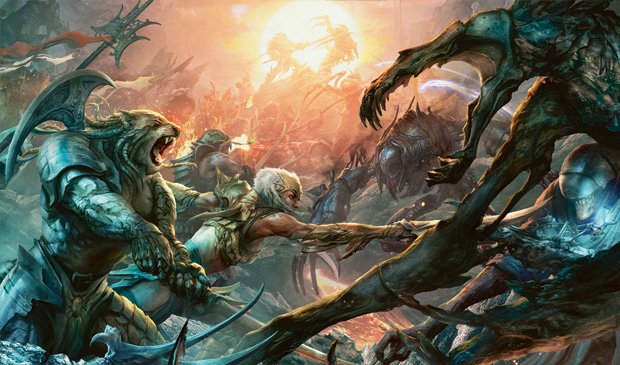
I then mapped out my idea. The Phyrexians would be in the fall set, but only in small numbers. There had to be a hint of that threat, but the set would be more about the return to Mirrodin. We had to remind the player base what Mirrodin was. Then, in the middle set we would have the war. We would see the two sides evenly matched (in card number, anyway) and we could get the players excited about who they wanted to win. Bill then asked, "But won't the name of the third set give it away?" That was a problem we had to solve, I said.
Bill then suggested that we just don't tell the players the third set's name. What if it had two names and we didn't let them know what it was until it was close to being released? I loved Bill's idea—so much so that I went up to Brand that day and asked them, "How crazy would it be to have two names for a set and not tell the public what it was until shortly before the set comes out?"
Brand Manager Mark Purvis thought about the question. I could see the wheels spinning in his head. After a beat he said, "I have to talk to some people." A few days later he came up to me and said, "I think we can do it. I've talked to Sales and Marketing and they're both on board. Everyone's willing to sell the product where the people buying it don't even know which of the two names will be on the box."
I often talk about how I have an idea and I have to convince everyone that it's good. Sometimes, though, everyone just recognizes a good idea. The block model of Phyrexian vs. Mirran was one of the latter cases. Having two set names is pretty odd, but everyone got on board almost immediately. Making the block about pitting two famous forces of Magic's past seemed pretty exciting.
- Mapping Out Phyrexia
So we had our three beats for our block plan:
Set 1 – Return to Mirrodin with hint of Phyrexian threat
Set 2 – War between Mirrans and Phyrexians
Set 3 – See world reshaped by Phyrexians after they win the war
The big question, though, was how exactly we could show progression through the block. With work, we found a few ways:
- Faction Percentages
This was the idea I had the earliest for how to evolve the block. Start the first set with the Phyrexians just a small amount of the set. Have the second set be even to show off the two sides without tipping our hand. (And yes, there is a strong argument that this did tip our hand, and kudos to those of you that figured this out.) Then have the third set be mostly Phyrexians.
The reason I felt faction percentages were so important was that I was trying hard to convey the sense that the Phyrexians are corrupting the Mirrans. Remember that the Phyrexians grow their numbers by turning other creatures into them. This meant that each member gained by the Phyrexians was one lost by the Mirrans. The faction percentages captured this flavor exactly. The other major issue was making sure that the difference between the sets was as great as possible so that the audience could see and feel the difference. I reached the percentages we ended up with by asking what the lowest and highest percentages were that would still give us the game play we needed.

As I explained during my first Mirrodin Besieged preview column (Under Besiege, Part 1), the idea of watermarks came up during Mirrodin Besieged design. While everyone felt we needed some watermarks, I was firmly in the camp that almost everything (save basic lands and planeswalkers) needed them. Without the watermarks, I argued, it would be almost impossible to see the percentages in each set. I wanted the public to get that 80%-20% became 50%-50%, which became closer to 10%-90%.
Without strong messaging, it would be very easy to miss something as nebulous as faction percentages. That's why I pushed so hard for the watermarks and made sure everyone made a point of it when talking about Scars of Mirrodin on the website.
- Color Spread
If we wanted to show Phyrexian corruption, I suggested that we could use Magic's most powerful tool, the color pie. The idea is simple: Have the Phyrexian mechanics start in certain colors and then have them spread as the block evolves. This would capture the sense of the Phyrexian influence spreading. For example, let's look at infect.
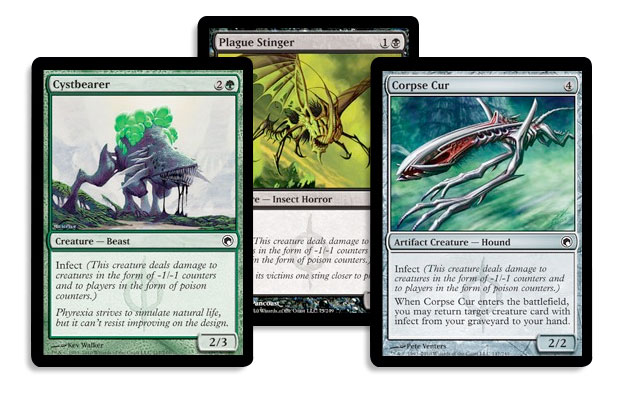
- In Scars of Mirrodin – Infect is in black and green and artifacts.
- In Mirrodin Besieged – Infect still shows up in black, green and artifacts, but now begins showing up in white and on one card in blue.
- In New Phyrexia – Everyone gets some infect loving, even red.
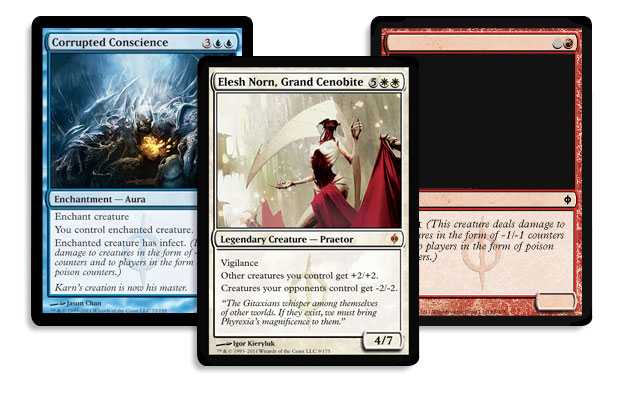
Let's examine proliferate:
- In Scars of Mirrodin – Proliferate is in blue and artifacts.
- In Mirrodin Besieged – Proliferate is still in blue and artifacts but now shows up on a black card and a green card.
- In New Phyrexia – Once again, all the colors get to join in on the fun (at least during design; after development, one color ended up without any proliferate cards).
This color shift was important in several ways. First, it demonstrated the Phyrexian influence growing and corrupting. Second, it allowed later sets to add new things while not having to introduce extra mechanics. Third, it helped shake up the Limited environment. In Scars of Mirrodin–only draft, infect is restricted to black and green. Once Mirrodin Besieged gets into the mix, white become a viable option. When New Phyrexia gets added, you will see that infect decks have a new set of choices (especially because the New Phyrexia booster pack will be drafted first).
- Mechanical Evolution
This was an area that I thought would be very important but that in the end was not as key as I expected. For example, we designed living weapon in Scars of Mirrodin design. When we made the shift to the Mirran / Phyrexian conflict, we moved living weapon back to the third set, the thought being that living weapon was the end state of Phyrexians corrupting Mirrodin's Equipment.
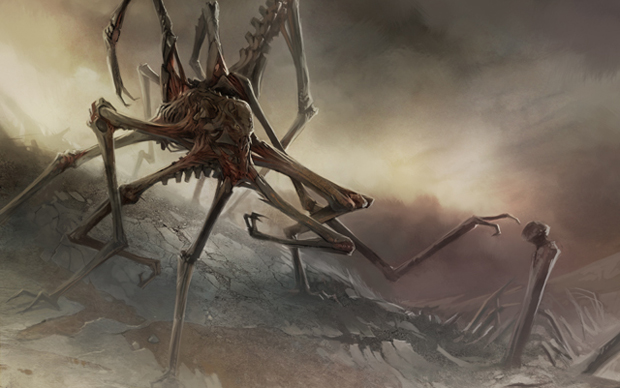
We even designed a twist on Equipment that felt like an intermediary between normal Equipment and living weapon that we put into Mirrodin Besieged. (I'd tell you what it was, but I liked it enough that I know we're going to use it somewhere.) The thought behind this was that watching the Equipment change would give a sense of evolution. What we found, though, was that the set had so many different things giving this message that it wasn't necessary.
Instead, living weapon was moved from New Phyrexia to Mirrodin Besieged, as we wanted to have a mechanic for each side in the war and living weapon was our favorite Phyrexian mechanic (well, of the ones not already in Scars of Mirrodin). I will let fans of living weapon know that New Phyrexia does have more living weapon cards. Mirrodin Besieged lead developer Erik Lauer and New
The reason the mechanic evolution didn't pan out as I imagined had a lot to do with how we ended up designing New Phyrexia. Rather than make it the end of a three-set evolution, we decided to make New Phyrexia have a much stronger shift. It wasn't the end of the change, but an entire fundamental altering of the world. The first two sets watched as the Phyrexians took over the Mirrans' home. New Phyrexia was us coming back to see how they redecorated it.
- Corruption of the Known
The last tool we used for evolution was small in number but very big in feel. If the Phyrexians were going to be corrupting all things Mirran, then we needed to produce some Phyrexian cards that were corrupted versions of known Mirran things.
The most iconic ones, such as Blightsteel Colossus and Inkmoth Nexus, were remade versions of iconic cards from the original Mirrodin block, but there are also cards in the block that are first shown on the Mirran side and then shown in their corrupted Phyrexian form, either in later sets or (frequently in Mirrodin Besieged) in the same set. As the world transitions from Mirrodin to New Phyrexia, we wanted the tragedy of what was happening to seep throughout the set.
One quick final aside: The Phyrexians are villains. The corruption of Mirrodin is not supposed to be a happy thing. What has happened is truly evil and awful, but the goal of this block was to reintroduce the Phyrexians as villains and establish that they are truly a malevolent force in the multiverse. Don't worry, this isn't the last you're going to see of them.
- To Hell and Back
That's all I got for today. I hope this little peek into how Scars of Mirrodin block actually evolved was interesting. I have plenty more to say, but I'll wait for three weeks from now when New Phyrexia previews begin. Join me next week when I write the final article of my "Roseanne" trilogy.
Until then, may you be willing to audible when things aren't quite going like you need them to.

